Duncan Watson reviews ‘Ceol Mor for the Great Highland Bagpipe, presented in The Balmoral Tradition’, by James McIntosh.
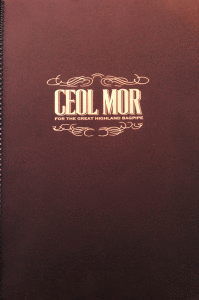 The terms ‘Balmoral Tradition’ and ‘Balmoral School’, these have been used before, although Bob Nicol was at pains to point out that what he and Bob Brown (pictured above with the author) passed on was not created at Balmoral but by John MacDonald of Inverness.
The terms ‘Balmoral Tradition’ and ‘Balmoral School’, these have been used before, although Bob Nicol was at pains to point out that what he and Bob Brown (pictured above with the author) passed on was not created at Balmoral but by John MacDonald of Inverness.
I attended Bob Nicol for many years and found he was down to earth, had no pretentiousness, was courteous, fairly blunt at times….but inspiring. Piobaireachd was a lifelong study for him and Bob Brown. It is against this background that I shall attempt to review James McIntosh’s important new book, ‘Ceol Mor’. To avoid any confusion, there is an older publication entitled ‘Ceol Mor’ by General CS Thomason. It is a monumental piece of work and the Bobs, and their mentor, John MacDonald, made extensive use of it. MacDonald (1866-1953), was regarded as one of the most outstanding players and authorities of his time. In the 1950s, the School of Scottish Studies engaged the Bobs to make recordings illustrating what they were taught by him. Those recordings remain a valuable resource for all students of ceol mor as do the CDs in the ‘Masters of Piobaireachd’ series of instructional recordings intended to preserve what John MacDonald, Inverness, passed on.
The Bobs taught extensively and allowed pupils to record their lessons. John MacDonald was often mentioned, but if there was a tune which had not been covered by him, they would say so and add ‘but this is the way I would play it.’ I was always interested in Bob Nicol’s views, but more so on how John MacDonald may have played. When teaching, the Bobs paid particular attention to phrasing and accents within phrasing (the imparting of which should be the pursuit of all those who teach). This was done by conducting the piper through the tunes, singing, expressing and vocalising the accents in informal canntaireachd.
All pupils got the same kind of treatment. James McIntosh would have experienced this and has quite correctly based the writing of his book on it. ‘Ceol Mor’ is described as a tutor book and is in three sections, the first containing biographical details of the author and the Bobs, the second, various details about the importance of oral transmission of the music and how tunes might be interpreted, and the third is on specific tunes. The notation is presented on the stave in the usual way, but without bar lines and time signatures. In the Piobaireachd Society and Kilberry books and some others, cadence motifs with small-headed inverted notes are the norm, whereas James uses large-headed notes with stems as you would for theme notes. In this it is similar to some of the writings of Angus MacKay and others – and there is worth in it.
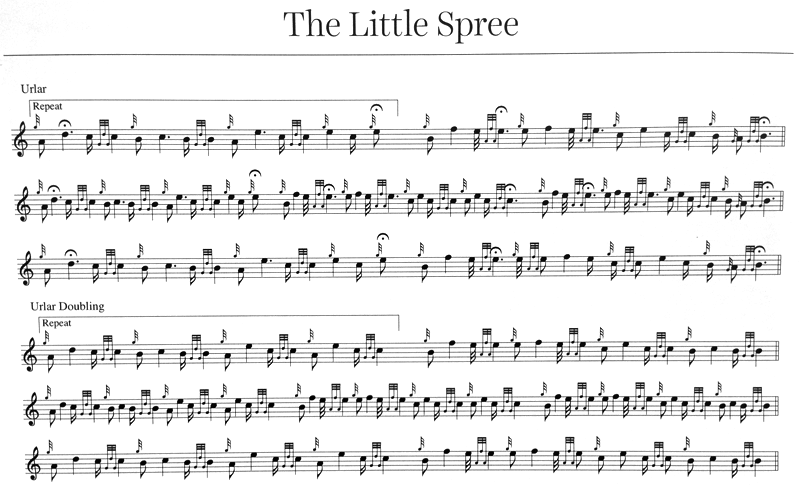
Without time signatures, the author has the freedom to employ relative note values to indicate accurate timings as he was taught. Phrases are delineated by spacing rather than by breaks in the stave. In this the book is similar to ‘Binneas is Boreraig’. Whilst the phrases in B is B are written in isolation and repeated as per a written instruction, James writes out fully the ground and variations (except for the taorluath and crunluath). Writing the tunes in this way has its advantages in that in recycled phrases there are sometimes slight differences in timing which cannot be shown with a simple ‘play phrase 2 line 1’ instruction. There is an example of this in the ground of the Lament for MacSwan of Roaig. The notation in the first two-bar phrase of line 1 is the same as the last two-bar phrase in that line, and it also occurs at the end of line 2. James alters the note value very slightly and this adds a touch of expression to the music, though very difficult to portray on paper.
Bob Brown’s frequent reference to scansioned beats is perpetuated by James and he describes these in tunes cast in 2/4, 3/4 and 4/4 time using the terms ‘strong’ and ‘medium’. Bob Nicol did not use such an approach or measurement. Both Bobs made reference to the time signatures in which tunes were set, but were of the opinion that the mathematics of staff notation did not accurately portray the musical way in which tunes should be played. ‘Scansioning’, for want of a better word, can be overdone and should not be regarded as an immutable rule to every tune and every variation; a useful guide and no more in my view. There is certainly something of a dichotomy in abandoning time signatures and bar lines and replacing them with strict scansioned beats.
At the end of some phrases/lines, James occasionally writes minims (1/2 notes), clearly a commendable effort to show the ends of phrases or lines; but such a very long note can be misleading without heed to a tutor or oral reference. There is also wide use of regular fermatas in the book, and this occurs occasionally on neighbouring theme notes of equivalent length. Sometimes a short fermata symbol (an inverted V with a dot in the middle) might have softened what may appear to be over strict delineation of phrases.
Naill Pipe Chanter:
On page 27, James, having discussed inappropriate use of fermata symbols and the harmful way embellishments are played, writes, ‘One of the consequences of this is that we may finish up with a panel of judges who can only understand and appreciate ‘book playing’. We may already have that situation.’ He goes on to say, ‘Today some of our players are apprehensive about playing something that is not in the book; evidence that judges DO influence and determine the direction our music takes through their results.’ This is obviously true and a consequence of competitive piping. It is an inescapable fact that at times, major prizes have been won with ‘bookish playing’ as James describes it. On page 21 he poses the question, ‘Could it be that ….a few successes made (make) the successful competitor feel they needed (need) no further study? I believe that this is the way it is today.’ Bob Nicol had a more direct approach when he told me, ‘Prizes don’t alway equate to good playing!’
There is comment on notation before and after 1895 with reference to what appears in Glen’s collection. A study of old publications and manuscripts confirms this, but the date is arbitrary. James says that the newer ‘scientific’ way embellishments have been written adversely affects the playing of the music. He suggests that the Piobaireachd Society are perpetuating this by continuing to adopt the modern method. For example he refers to the throw on E, the ‘dre’, and holds that the way in which it is now written with the short E gracenote at the start adversely affects the playing of the crunluath. He refers to having judged a Highland Society Gold Medal competition in 2011 and being ‘astonished’ at the playing by one piper of the ‘dre’ in the Lament for MacDonald’s Tutor, forecasting difficulties later in the tune with the crunluath – and so it proved. James may be right, but we have to be careful when generalising on the basis of the performance of one individual. Having listened to virtually every Gold Medal and Clasp competition at Inverness for the last 10 to 12 years, where we might expect technique of the highest level, there are times the crunluath has been played in what can only be described as an inaccurate or unbalanced way. This is not a new problem, but to be fair to the Piobaireachd Society, such inaccuracies cannot always be blamed on how these movements are written.
James refers to the D throw and writes two motifs, one with the demi-semi-quaver low G, pre-1895, and the other with semi-quaver, post 1895, but this last appears in the Angus MacKay book published in 1838. In some of the older publications and manuscripts, the D throw is often written in what may be described as the ‘grip’ style and that is the way Bob Brown expressed it. There are mixed views on this topic, some preferring throws with the grip and others the lighter method. There is no reference made to this and none of the tunes in the book are written with the D throw in the grip style. The notational style of writing embellishments has a selective and revisionist flavour which is not all bad.
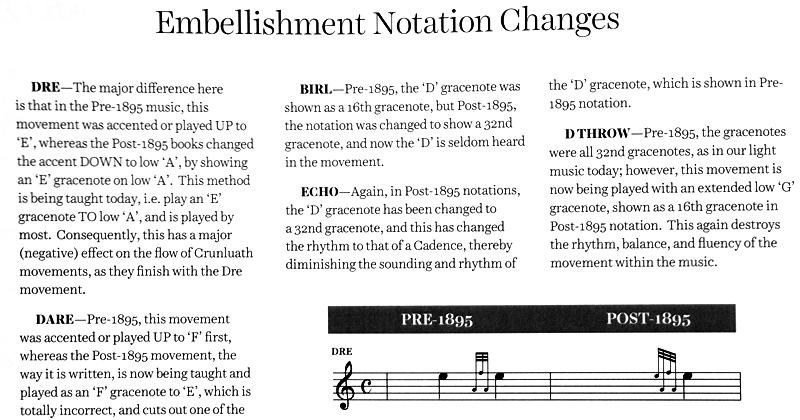
An excerpt from the section on notation changes
Worth mentioning is the embellishment James refers to as the ‘Viscount Movement’. In canntaireachd vocables this is termed ‘chelalo’, ‘lal’ referring to the F component of the movement. Later in the book he features the tune but that movement is not included. Instead there is what may be described as a conventional double D. This is sourced from Thomason’s Ceol Mor. James does make brief reference to this in notes regarding the tune. The same movement also occurs in the Lament for Alasdair Dearg McDonnell of Glengarry in the third line of the ground, but the notational style discussed in section two of the book is not adopted, large headed notes as in theme notes used instead.
There is reference to the ‘Departure Movement’, the unique high G grip with a high A grace note which appears in the first variation of The Lament for the Departure of King James (though the tune doesn’t feature in the book). The author has two motifs, one with the high A gracenote as the older version and with a high G gracenote on the more modern version. In actual fact the older version appears in the Piobaireachd Society collection and the newer version in the Kilberry Book, interesting perhaps, that the editor of both books is Archibald Campbell.
Continuing on the theme of embellishments, a tune not in the mainstream, The Cave of Gold, may be of interest in that it is to appear in the forthcoming PS Book 16. G F Ross included it in his book, having sourced it from the works of Simon Fraser, Australia. RU Brown evidently obtained the tune during a visit to British Columbia. What will be written in the Piobaireachd Society book differs slightly from what James writes, the darodo or ‘bubbly note’, terminating on low A instead of B. The other difference occurs in the first variation where there are F gracenotes following E. At the moment this is unique to the second variation of His Father’s Lament for Donald MacKenzie (though common in Donald MacDonald’s dithis variations).
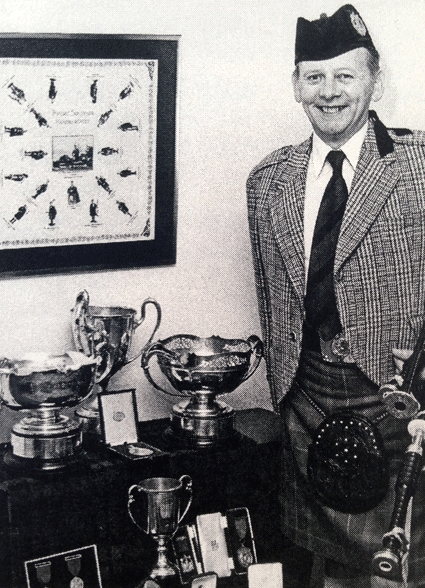
Echoing beats on D were sometimes played by the Bobs with a C gracenote instead of low G on the first beat, and this is printed in some of the old sources; it can produce an attractive delicate touch and can be heard on some old recordings. In James’s book, perhaps surprisingly, all of those D echoing beats have low G gracenotes.
In B double echoes James sometimes writes the D gracenote as a quaver (eighth note) and at other times as a demi-semi-quaver. There is good reason for this as often players crush this gracenote so much that it is hardly heard. In the low A beat we refer to as hiharin, he writes the D gracenote as a quaver. Again, many players sound that D gracenote so short as to be barely audible; if this book can change that habit well and good.
There are 72 tunes in the book and James’s choice mildly surprised me. Included is the Battle of Auldearn No 1, although, according to Nicol, it was not taught by John MacDonald, tune No 2 being the favoured setting. The Lament for Ronald MacDonald of Morar is a very fine tune, but it appears from what the Bobs have said, and indeed the commentary by James, that John MacDonald was at odds with it because of the confusing diversity of settings. For the Stewarts White Banner, John MacDonald, evidently, had no enthusiasm, describing variation 1 as resembling the neighing of a horse! There are tunes that I expected to find but which have not been included: My King Has landed in Moidart and Isabel MacKay. Also missing is The Lament for Donald Ban MacCrimmon. I understand that John MacDonald treated this tune with reverence even to the point that competing with it was in some way demeaning to it. Bob Nicol played the tune at MacDonald’s funeral and at Bob Brown’s. The late Pipe Major Donald MacLeod, also a pupil of John MacDonald, later commented that Nicol gave an object lesson on the playing of the first variation. Perhaps these missing tunes could be included in a second edition.
Shepherd Reed Set:
The book is well written although inevitably there are mistakes which will no doubt be corrected for the second edition, and in any case the Piobaireachd Society books are a fairly reliable reference when confusion arises. I enjoyed reading the book and recognising aspects of what Bob Nicol taught. Any differences that I have may illustrate that we all hear and pick up things differently. In respect of teaching and learning, a one-to-one relationship between teacher and pupil is the ideal. The use of recordings is acknowledged to be a good second best and to that end James has started to make audio recordings available on his website.
This book will be an enjoyable and useful addition to every piobaireachd enthusiast’s library and James is to be commended for recording for posterity how he remembers his teaching with those Masters of Piobaireachd, RU Brown and RB Nicol, Balmoral.










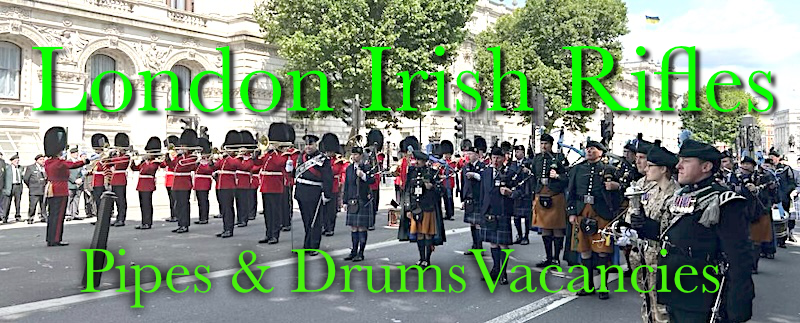






Thank you Duncan, very informative!